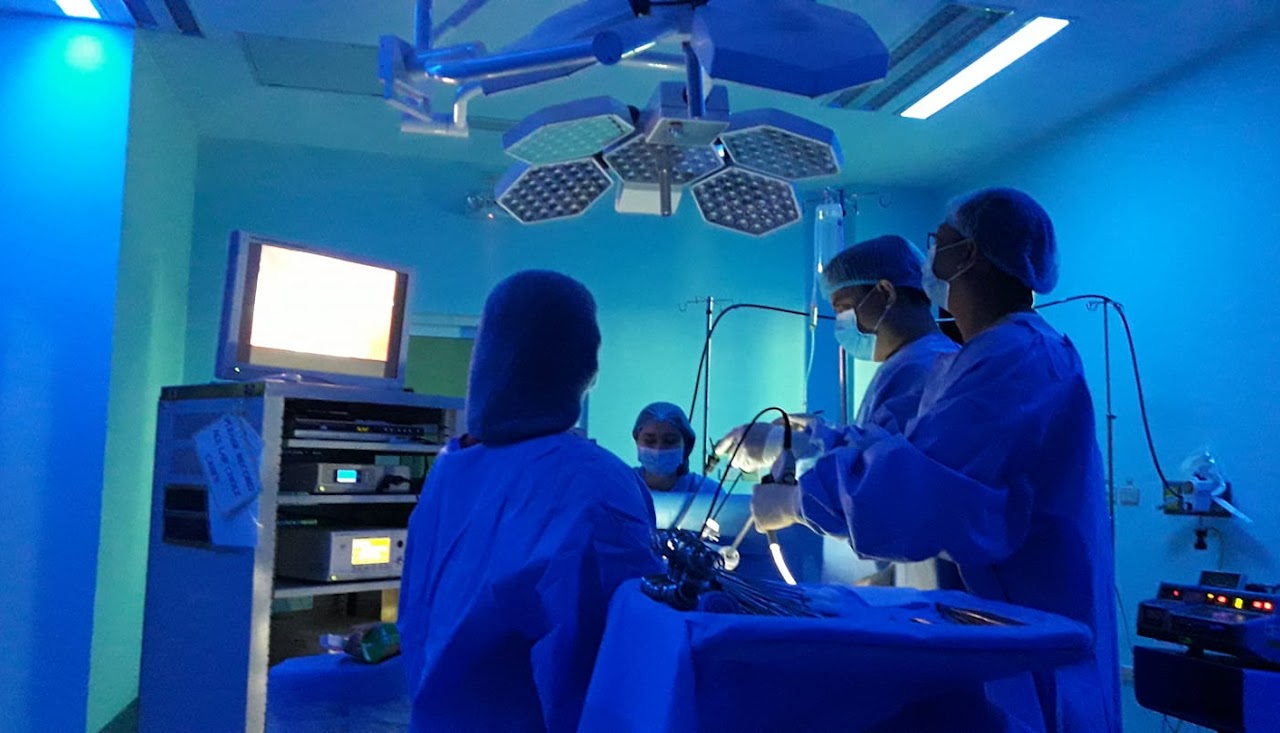This article was originally published on https://drrommelromero.com and has been republished with permission. Author: Rommel E. Romero, MD
Laparoscopic surgery, also known as minimally invasive surgery, has revolutionized the field of medicine by offering a gentle approach to major surgical procedures. Unlike traditional open surgeries, laparoscopic surgery utilizes small incisions and specialized instruments to minimize trauma to the body. This article explores the benefits, procedures, advancements, and potential risks associated with laparoscopic surgery.

Introduction
In recent years, laparoscopic surgery has gained immense popularity due to its numerous advantages over traditional open surgeries. This technique allows surgeons to perform complex procedures with minimal invasiveness, resulting in reduced pain, faster recovery, and improved cosmetic outcomes.
What is Laparoscopic Surgery?
Laparoscopic surgery involves the use of a laparoscope, a thin tube with a camera and light source, which is inserted through a small incision in the patient’s body. This allows the surgeon to view the internal organs on a monitor and perform the surgery using specialized instruments inserted through additional small incisions.
Advantages of Laparoscopic Surgery
Laparoscopic surgery offers several advantages compared to traditional open surgeries. Firstly, it significantly reduces trauma to the body, as the incisions are much smaller. This leads to less blood loss, lower risk of complications, and shorter hospital stays for patients.
Secondly, laparoscopic surgery results in reduced scarring. The small incisions heal faster and leave only small marks, which are far less noticeable than the large scars typically associated with open surgeries. This is particularly important for patients who value their aesthetic appearance.
Thirdly, the recovery time after laparoscopic surgery is generally faster. Patients experience less pain and discomfort, allowing them to return to their daily activities sooner. In many cases, patients can be discharged from the hospital on the same day as the surgery.
Common Procedures Performed with Laparoscopy
Laparoscopic surgery can be used to perform a wide range of procedures, including:
Hysterectomy
Laparoscopic hysterectomy is a minimally invasive alternative to traditional open hysterectomy. It involves the removal of the uterus using small incisions, resulting in less pain, reduced scarring, and a shorter recovery period.
Gallbladder Removal
Laparoscopic gallbladder removal, also known as cholecystectomy, is a common procedure for treating gallstones. Through small incisions, the surgeon removes the gallbladder using specialized instruments, resulting in minimal postoperative discomfort and a faster recovery.
Hernia Repair
Laparoscopic hernia repair is an effective method for treating various types of hernias, including inguinal, umbilical, and incisional hernias. The surgeon inserts a laparoscope and repairs the hernia using mesh patches, resulting in quicker recovery and lower risk of recurrence.
Appendectomy
Appendectomy, the surgical removal of the appendix, can also be performed using laparoscopic techniques. This approach offers patients a faster recovery, less postoperative pain, and a lower risk of complications compared to traditional open appendectomy.
The Laparoscopic Procedure
The laparoscopic procedure involves several key steps that allow surgeons to perform complex surgeries with precision and minimal invasiveness.
Preoperative Preparation
Prior to the surgery, patients are evaluated through thorough physical examinations, laboratory tests, and imaging studies. The surgeon discusses the procedure, potential risks, and benefits with the patient, and obtains informed consent.
Anesthesia and Incision
During the surgery, the patient is placed under general anesthesia to ensure comfort and safety. The surgeon makes several small incisions, usually less than an inch in length, through which the laparoscope and surgical instruments are inserted.
Insertion of Trocars
Trocars, hollow tubes with valves, are inserted into the incisions to provide access for the laparoscope and instruments. Carbon dioxide gas may be used to inflate the abdomen, creating space for the surgeon to maneuver the instruments.
Laparoscope and Surgical Instruments
The laparoscope, connected to a high-resolution camera, is inserted through one of the trocars. This allows the surgeon to visualize the internal organs on a monitor and guide the surgical instruments with precision. The surgeon carefully manipulates the instruments to perform the necessary surgical tasks.
Completion of the Procedure
Once the surgery is completed, the surgeon removes the instruments and trocars, and the small incisions are closed with sutures or surgical glue. Bandages or dressings may be applied to protect the incision sites.
Benefits for Patients
Laparoscopic surgery provides numerous benefits for patients undergoing major procedures. These include:
Reduced Scarring
Due to the smaller incisions used in laparoscopic surgery, patients experience minimal scarring compared to traditional open surgeries. The cosmetic outcome is greatly improved, which can have a positive impact on self-esteem and body image.
Faster Recovery Time
Patients who undergo laparoscopic surgery generally experience a shorter recovery period compared to those who undergo open surgeries. The reduced trauma to the body results in less pain, decreased postoperative discomfort, and faster return to daily activities.
Less Pain and Discomfort
Laparoscopic surgery is associated with reduced postoperative pain and discomfort. The smaller incisions and minimized tissue trauma result in fewer nerve endings being affected, leading to a more comfortable recovery for patients.
Lower Risk of Infections
The risk of infections is significantly reduced with laparoscopic surgery. The smaller incisions and shorter hospital stays minimize the exposure of internal organs to potential pathogens, lowering the likelihood of surgical site infections.
Advancements in Laparoscopic Surgery
Over the years, laparoscopic surgery has seen significant advancements that further enhance its effectiveness and safety.
Robotic-Assisted Laparoscopy
Robotic-assisted laparoscopy combines the benefits of laparoscopic surgery with the precision and versatility of robotic technology. The surgeon controls robotic arms with enhanced dexterity and performs complex procedures with increased accuracy and reduced fatigue.
Single-Incision Laparoscopy
Single-incision laparoscopy, also known as single-port laparoscopy, takes minimally invasive surgery to the next level. Through a single small incision, the surgeon inserts multiple instruments, including the laparoscope, to perform the procedure. This technique further reduces scarring and improves cosmetic outcomes.
Potential Risks and Complications
While laparoscopic surgery is generally safe, it carries some potential risks and complications. These may include:
- Bleeding
- Infection
- Organ or blood vessel damage
- Anesthesia-related complications
- Adverse reaction to carbon dioxide gas
It is important for patients to discuss these risks with their surgeon and follow pre- and post-operative instructions carefully to minimize the chances of complications.
Conclusion
Laparoscopic surgery has revolutionized the field of medicine by offering a gentle approach to major procedures. Its numerous advantages, including reduced scarring, faster recovery time, less pain, and lower risk of infections, make it a preferred choice for patients and surgeons alike. With ongoing advancements, laparoscopic surgery continues to evolve, providing patients with safer and more effective treatment options.
FAQs
Q: How long does a laparoscopic procedure typically last?
A: The duration of a laparoscopic procedure depends on the complexity of the surgery. Generally, it can range from 30 minutes to a few hours.
Q: Will I have visible scars after laparoscopic surgery?
A: Laparoscopic surgery leaves small incisions that heal well and result in minimal scarring. The scars are typically small and less noticeable compared to those from open surgeries.
Q: Can all surgeries be performed laparoscopically?
A: Not all surgeries can be performed laparoscopically. The feasibility of laparoscopic surgery depends on various factors, including the patient’s condition, the complexity of the procedure, and the surgeon’s expertise.
Q: Is laparoscopic surgery more expensive than traditional surgery?
A: Laparoscopic surgery may have higher initial costs due to the specialized equipment required. However, it can result in shorter hospital stays and faster recovery, potentially reducing overall healthcare expenses.
Q: What should I expect during the recovery period after a laparoscopic procedure?
A: Recovery after laparoscopic surgery varies depending on the specific procedure and individual factors. Generally, patients can expect some soreness and discomfort for a few days, followed by a gradual improvement in their condition. It is important to follow the post-operative instructions provided by the surgeon for a smooth recovery.













